#chief crazy horse
Photo
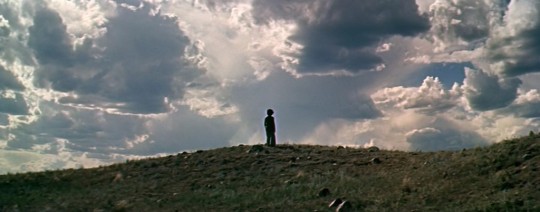
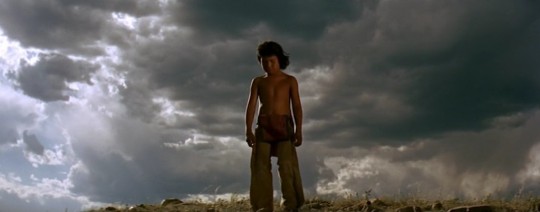
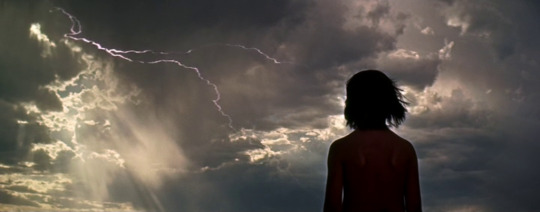
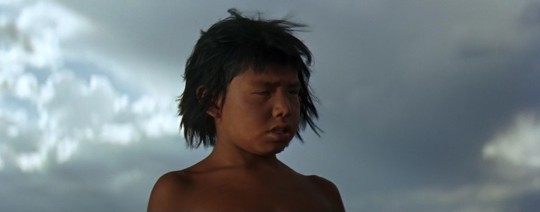

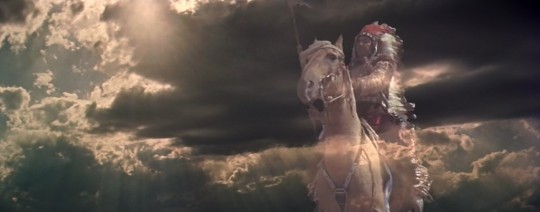
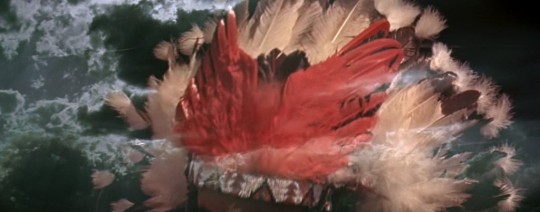
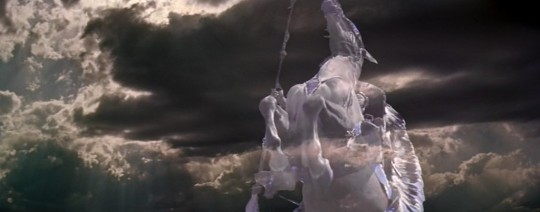
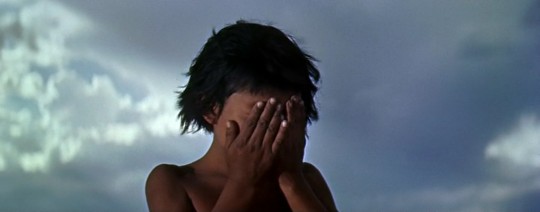
Chief Crazy Horse (George Sherman, 1955)
13 notes
·
View notes
Text
⚞Chief Red Shirt⚟
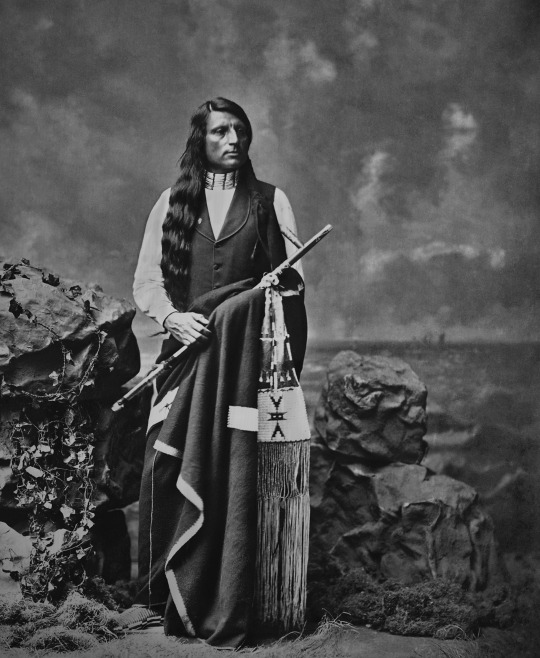
Chief Red Shirt - Oglala Sioux

Red Shirt (Oglala Lakota: Ógle Ša in Standard Lakota Orthography) (1847–1925) was an Oglala Lakota chief, warrior and statesman.
Chief Red Shirt camped with Crazy Horse and the rest of the Oglala at the Little Big Horn. The Oglala camp was next to the Cheyenne camp near the bottom of what is now known as Last Stand Hill. Red Shirt supported Crazy Horse during the Great Sioux War of 1876-1877 and the Ghost Dance Movement of 1890, and was a Lakota delegate to Washington in 1880.

Dakota delegation to Washington, D.C., Left to right, Red Dog, Little Wound, John Bridgeman (interpreter), Red Cloud, American Horse and Red Shirt. June, 1880
Chief Red Shirt wore his hair to represent peace and war. One side of his hair was wrapped to indicate he was ready for peace, the other side was worn loose indicating his readiness for war. This was done when he traveled with Chief Red Cloud to Washington D.C.

Red Shirt surrendered with Crazy Horse in 1877. After the surrender he moved to an area that is now known as Red Shirt, SD. Red Shirt was one of the first Wild Westers with Buffalo Bill's Wild West and a supporter of the Carlisle Native Industrial School. Red Shirt became an international celebrity Wild Westing with Buffalo Bill's Wild West and his 1887 appearance in England captured the attention of Europeans and presented a progressive image of Native Americans.
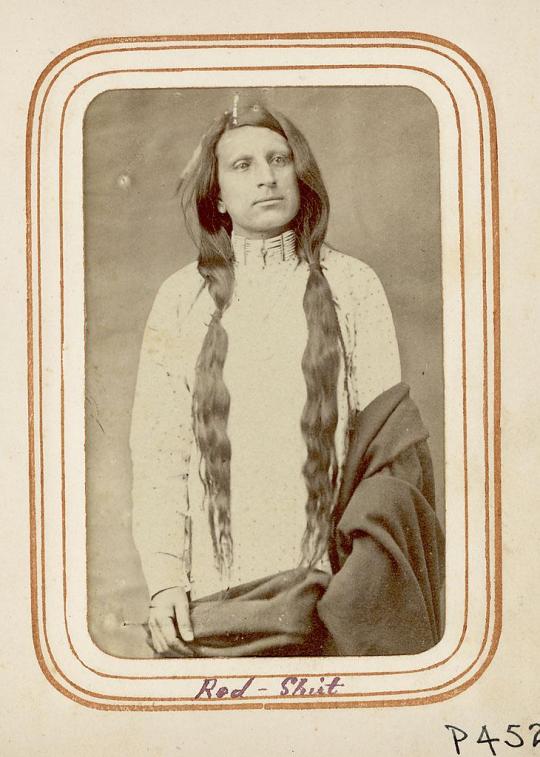

Red Shirt in Buffalo Bill's Wild West Show
On March 31, 1887, Chief Red Shirt, Chief Blue Horse and Chief American Horse and their families boarded the SS State of Nebraska in New York City, leading a new journey for the Lakota people when they crossed the ocean to England on Buffalo Bill's first international to perform at the Golden Jubilee of Queen Victoria and tour through Birmingham, Salford and London over a five–month period. The entourage consisted of 97 Indians, 18 buffaloes, 2 deer, 10 elk, 10 mules, 5 Texas steers, 4 donkeys, and 108 horses. Buffalo Bill treated Native American employees as equals with white cowboys. Wild Westers received good wages, transportation, housing, abundant food and gifts of clothing and cash from Buffalo Bill at the end of each season.
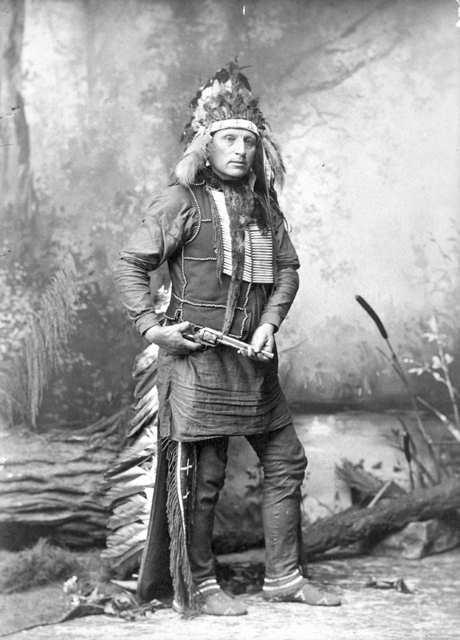
Photo from London - Red Shirt was lionized by the British press and his handsome features and stately bearing caused reporters to hang on his every word. Queen Victoria adored Chief Red Shirt and reportedly said after meeting him, "I know a real prince when I see him."

William F. "Buffalo Bill" Cody, Rosa Bonheur, Chief Rocky Bear, Chief Red Shirt, William "Broncho Bill" Irving, Roland Knoedler, and Benjamin Tedesco in front of Cody's Tent at the Paris Exposition Universelle - 1889
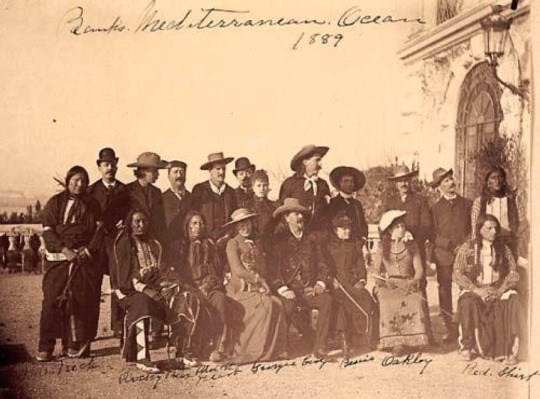
Another photo of Red Shirt - this time with Cody's company somewhere in Italy, 1890. Front row: No Neck, Rocky Bear, Black Heart, Georgie Duffy, Cody, Bessie Farrell, Annie Oakley, Red Shirt. Others in back row: Buck Taylor (fifth from right), Johnny Baker (fourth from right), Carter Couturier, advertising agent(?) (second from right), Has No Horses (far right)


Chief Red Shirt's rifle & scabbard.🔼 - Details 🔽




Chief Red Shirt was a Wild Wester for over thirty years - St. Louis World's Fair, 1904.
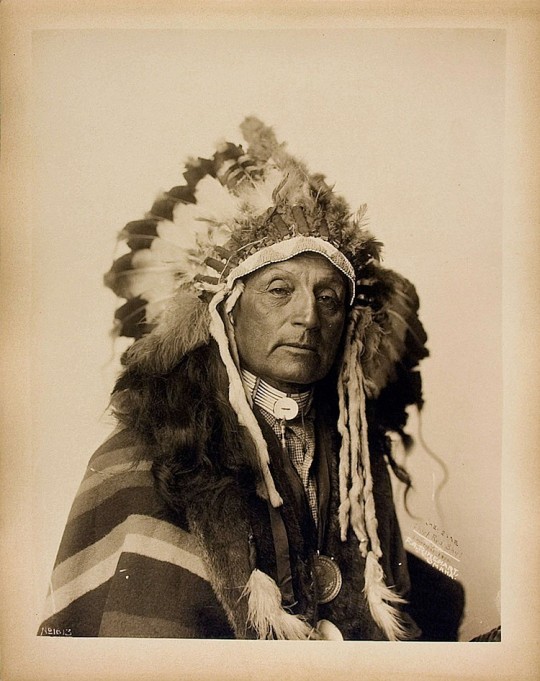
Chief Red Shirt (Ógle Ša) - 1847–1925
#indigenous#Sioux#native american#red shirt#Chief Red Shirt#buffalo bill#queen victoria#crazy horse#Little Big Horn#Oglala#ghost dance movement#lakota sioux#lakota#ogle sa#wild wester
298 notes
·
View notes
Text
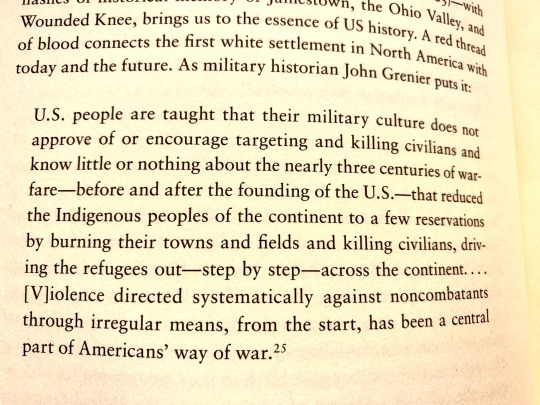
“U.S. people are taught that their military culture does not approve of or encourage targeting and killing civilians and know little or nothing about the nearly three centuries of war-fare-before and after the founding of the U.S.-that reduced the Indigenous peoples of the continent to a few reservations by burning their towns and fields and killing civilians, driving the refugees out--step by step--across the continent....Violence directed systematically against noncombatants through irregular means, from the start, has been a central part of Americans' way of war. “
Military Historian John Grenier
#us history#wounded knee#sand creek#trail of tears#the long walk#bear river#thanks taking#in Country#🇺🇸#land back#crazy horse#tecumseh#sitting bull#Geronimo#chief joseph#emiliano zapata#Joaquin murrieta#Pó Pay#captain Jack#war crimes
148 notes
·
View notes
Text

The chief (V.1)⛺️🪶
#the chief#war bonnnet#headdress#naive art#art brut#jean michel basquiat#basquiat#folk art#outsider art#redskins#first nation#first nations#crazy horse#sitting bull#lakota sioux#lakota#standing rock sioux#standing rock#north dakota#tomahawk#powwow#american indian#indigenous rights#indigenous pride#indigenous people#indigenous peoples day#indigenous#native american#iroquois#apache
3 notes
·
View notes
Text
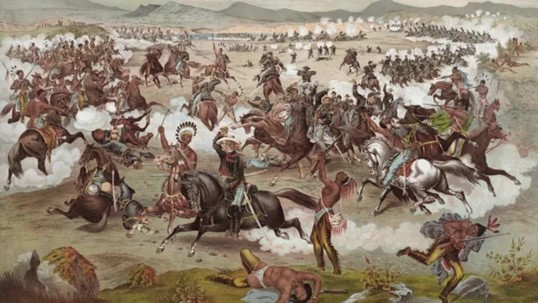
Horse warfare between Lakota and other Plains Indians and the U.S. Cavalry during the Battle of Little Bighorn , 1876.
Artist name and date??
Notes:
In 1876, General Custer and members of several Plains Indian tribes, including Crazy Horse and Chief Gall, battled in eastern Montana in what would become known as Custer's Last Stand.
The only survivor was a horse.
#Lakota tribe#Plains Indians#U.S. Cavalry#Battle of Little Bighorn#horse#war#Custer's Last Stand#Crazy Horse#Chief Gall#Montana#General Custer
1 note
·
View note
Text
Rolls over
So Wolfwood may allude to a Psychopomp,
Psychopomps (from the Greek word ψυχοπομπός, psychopompós, literally meaning the 'guide of souls') are creatures, spirits, angels, demons or deities in many religions whose responsibility is to escort newly deceased souls from Earth to the afterlife.
Their role is not to judge the deceased, but simply to guide them. Appearing frequently on funerary art, psychopomps have been depicted at different times and in different cultures as anthropomorphic entities, horses, deer, dogs, whip-poor-wills, ravens, crows, vultures, owls, sparrows, and cuckoos.
One notable Psychopomp is Charon(which is also one of Pluto's five moons) the ferryman who collected coins as payment, whose name is a poetic form of χαρωπός (charopós) 'of keen gaze', referring either to fierce, flashing, or feverish eyes, or to eyes of a bluish-gray color.
bluish-gray...

Another Psychopomp is Mercury, guider of souls to the underworld and "messenger of the gods", planet and metal named after him, noted as “both destructive and creative”.
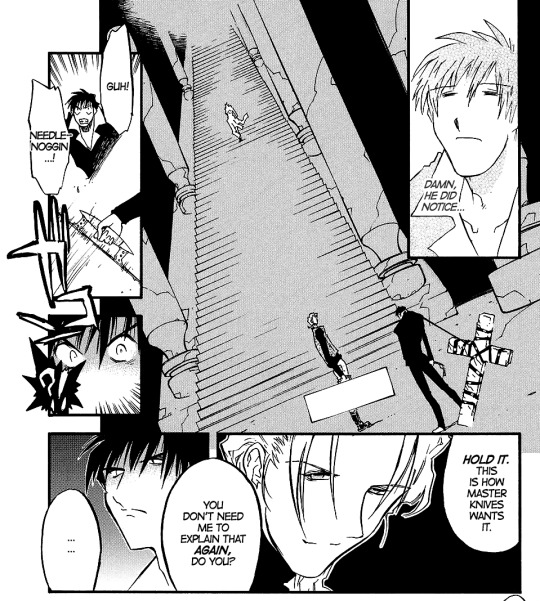
“The elusive, duplicitous Mercurius who consorts with the devil
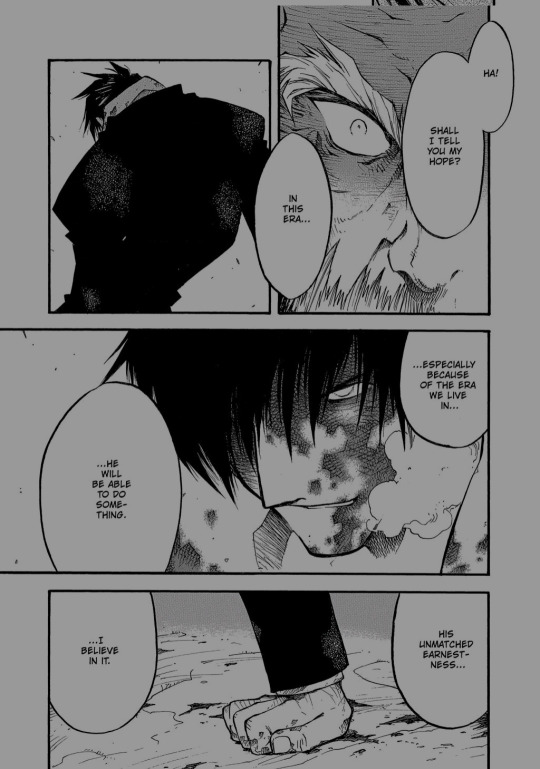
is at the same time a redeeming psychopomp”,
“The fact that he can freely participate in both light and dark worlds without taint makes Mercurius the perfect meditating bridge."
The metal known as quicksilver for being fluid and because of it's colour:

Silver...
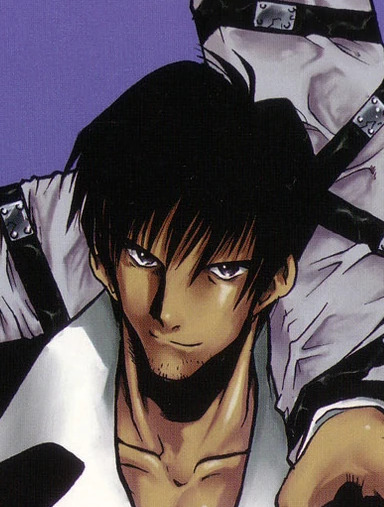
(Wolfwood I love you but finding a good shot of your eye-colour is a pain in the ass!)
Now in Stampede he doesn't have any of these eye-colours but his role as a Psychopomp is still alluded to via the undertaker title(those who were given burial rites are able to meet Charon and cross the river Styx) and of course, being outright called a guide(btw Saint Peter was also considered a Psychopomp:)).
Still with me? Now let's discuss Legato for a bit, This is still part of the Psychopomp thing because Orange might be doing something that's making me go crazy(in a good way).
In the manga Legato is Not a Psychopomp, he does have death imagery but invokes it via war and destruction, thus it associates him with Mars and iron, one well known iron-cyanide complex often used as a pigment is Prussian blue(Berlin blue, Paris blue) or "ferric ferrocyanide", and it looks like this:

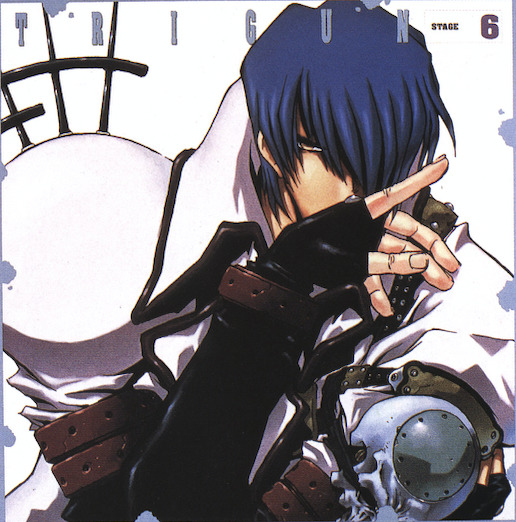
Now reason I'm pointing out that he's not a Psychopomp in the manga is because one of the lovely participants in Tristampparty had pointed out in their rewatch that Legato's eyes are

a greyish-silver and that surprised me and got me thinking, is Orange trying to give him Psychopomp allusions too? How? *Rolls over again* through Charon? He guide souls deeper into the underworld through the river Styx which could be referenced in how he "guides" lost souls into EOM.
And then hit it me, hehe, he's–, guys, he's the fucking Archangel Michael, chief of the angels and archangels, "stand ready and enter before the glory of the Lord". Meditating the "law of god" and standing at the right hand of the throne of god(right hand man, get it?).
Given permission to bring "righteous judgment" on the souls of the damned and bring those who are "worthy" of god to the gates of heaven.
"Bring them to the afterlife" would make him a Psychopomp as michael does guide souls but if you recall earlier they do not and cannot judge souls in the end so while micheal is theoretically a Psychopomp he does not embody it in its truest form, Micheal's role is a judge, jury and executer.
“The Lord punish you.”
And That’s it, the difference between Wolfwood and Legato's roles as Psychopomps, it is guide vs. judge, which uh, could also tie back to the twins.
(muttering, guide vs. judge, guide vs. judge... *tosses this into the steadily growing pile of "Orange might be foreshadowing a Wolfwood v. Legato fight in the future."*)
#trigun#nicholas d. wolfwood#legato bluesummers#trigun maximum#trigun stampede#I sound insane and for that I apologize but I've been chewing on this for awhile#and thinking “surely not but mayhaps???”
92 notes
·
View notes
Text
Ok but
AU where instead of killing Ganondorf Link frees him from a curse and it turns out gloom is something that possessed him and turned him evil and a little coo coo crazy.
And Link doesn't feel like murdering this guy who looks very confused as if he's awoken from a long slumber...so he explains him what he can and lets him tag along as he searches for a way to free Zelda from her dragon form.
Ganondorf helps Link out in his research because he feels responsible for what happened. If he hadn't been greedy and dug so deep for ancient ruins in search for power he wouldn't have been possessed by the gloom.
So Link and Ganondorf travel together and go on adventures.
Until they find out all sages have to gather and sacrifice their stones and they do and Zelda is back.
Aaand she's also very confused but also ready to go back to her projects for the kingdom.
Looking at Ganondorf makes her uneasy at first but she eventually comes to like him as he's not the same person she met in the past. His personality is completely different and she trusts Link.
A few headcanons to feed you
Ganondorf is an excellent cook
Ganondorf teaches Link how to train a bird of prey
During a trip to the desert Ganondorf brings Link to help retrieve an old stash of rupees he's hidden
Also he commissions custom clothes for Link and himself after teaching Gerudos ancient textile techniques! And these clothes protect from both heat and cold at the same time lol
Riju knows what's up but they decide to just tell everyone Ganondorf is just a chief from the past to avoid chaos
Ganondorf and Link totally start having a thing for each other but they are both conflicted for different reasons and it takes a lot of time before they give in and sleep together while out in a tent somewhere in the middle of nowhere. They swear this will mean nothing and that what they have is casual at most but it turns into a exclusive and committed relationship.
Insert taming a molduga mission here
They both have frequent night terrors so they hold each other in their sleep
Ganondorf is the guy who sits in the morning reading the newspaper with silly little reading glasses
Link gives Ganondorf the big black and red horse because what else is that man going to ride?
Ganondorf mostly travels after Zelda is saved. Sometimes along Zelda and Link, but mostly alone, to see most of the present world.
He eventually accepts to move in Link's house officially...even if they are rarely there. But some of his personal effects are around the house.
157 notes
·
View notes
Text
Heȟáka Sápa (Black Elk) (December 1, 1863 – August 19, 1950) was a famous wičháša wakȟáŋ (medicine man and holy man) and heyoka of the Oglala Lakota (Sioux) who lived in the present-day United States, primarily South Dakota. He was a second cousin of the war chief Crazy Horse.

Native American History
48 notes
·
View notes
Text
Masterlist

I guess I can update this now! If you haven't figured out by now I love Roman Reigns! I'm also pagan (some prefer the term polytheist because they see pagan as offensive but I don't) and a witch (not wiccan) I post about it regularly on my blog along with Roman. I write fanfics whenever I get the urge. I make gifs and post a lot of pictures.
I DO NOT give permission for my works to be translated or posted elsewhere! I DO NOT give permission for my stories to be fed to AI!! I don't own any wwe or any of their characters only my OCs. I cross post my fics on AO3 and Wattpad. I don't have fanfiction.net so if any of my stories are there that's not me!
They can take away our lives...... But they can never....take.... OUR METAL!!!!!🤘
Im Also a very loyal metalhead! I use it in my stories A LOT!! That metal growl is music to my ears!! I love it!!
I listen to 80s music and some 70s as well!
youtube
Do not watch ^^ if you're photosensitive!
youtube
Keys:
🫦 - smut
🪶 - fluff
💕 - romance
🤗 - comfort fic
😘 - hint of smut
🗡️ - violence
😤 - angst
Renegade - Au story (slow updates) 😤🗡️💕🫦
Part 1 part 2 part 3 part 4 part 5 part 6 part 7 part 8 part 9 part 10 part 11 part 12 part 13 part 14 part 15 part 16 part 17 part 18 part 19 part 20 part 21 part 22 part 23 part 24 part 25 part 26 part 27 part 28 part 29 part 30 part 31 part 32 part 33 part 34 part 35 part 36 part 37 part 38 part 39 part 40(last chapter)
Kingdom come
Part 1

Smut
Mr roboto 🫦😤💕
Hail to the king 🫦
Its all coming back to me now 🫦😤🪶💕
The perfect drug 🫦
Save a horse, ride a tribal chief 🫦
Simply irresistible 🫦💕
Girls, girls, girls 🫦
Holding out for a hero 🫦 🗡️🪶😤
Mexico🫦🪶💕
Anyway you want it 🫦
Bück dich 🫦 😤🪶
Hot for teacher 🫦
Rocket 🫦
Sexy santa 🫦
Ho hey 🫦💕🪶😤
Magic man 🫦💕
Push it 🫦
Wild side 🫦, 💕
Slow ride 🫦
War pigs 🫦
Lovin every minute of it 🫦,🪶
Kickstart my heart 🫦
Crazy little thing called love 🫦
Lick it up 🫦
Dreams 🫦💕
The stroke 🫦
Demon's are a girl's best friend 🫦
Fluff
Hysteria 🪶💕😘
Comfortably numb 🤗, 🪶
Wind of change 🪶, 🤗
Kiss the go-goat 🪶
I can't help falling in love with you 🪶
Home sweet home 😘, 🪶
Scream with me 😤 🪶🤗
The sound of silence 🪶🤗
Angst
Winged hussars 😤, 🪶
The first soldier 😤 🪶
2 part stories
Wellerman
Wellerman: part 2 🫦💕
Sick like me 😘
Sick like me: part 2 🫦💕
⚡ Thunderstruck⚡
⚡ Thunderstruck ⚡: part 2 🫦
❤️You're in love❤️
You're in love: part 2 - coming soon
Head cannons:
What I imagine Roman proposing would be like
Valentine's Day with roman
First date
Drabbles:
Armageddon it
These dreams
youtube
Lord Loki, defender of the outcasts, protect us from those who would do us harm!

73 notes
·
View notes
Text

The giant face of Chief Crazy Horse at the Crazy Horse Memorial that is being carved out of the granite Thunder Mountain in the Black Hills near Custer, South Dakota. The project refuses to take any government funding, meaning your grandchildren may see this finished, but you won't.
Link to article if you're interested. https://www.thepost.co.nz/a/travel/350019794/historic-snub-created-worlds-largest-mountain-carving
81 notes
·
View notes
Text
On Dec 15th, we venerate Elevated Ancestor & Saint Tataηka Íyotake aka Chief Sitting Bull on the 133rd anniversary of his passing 🕊 [for our Hoodoos of First Nations descent]
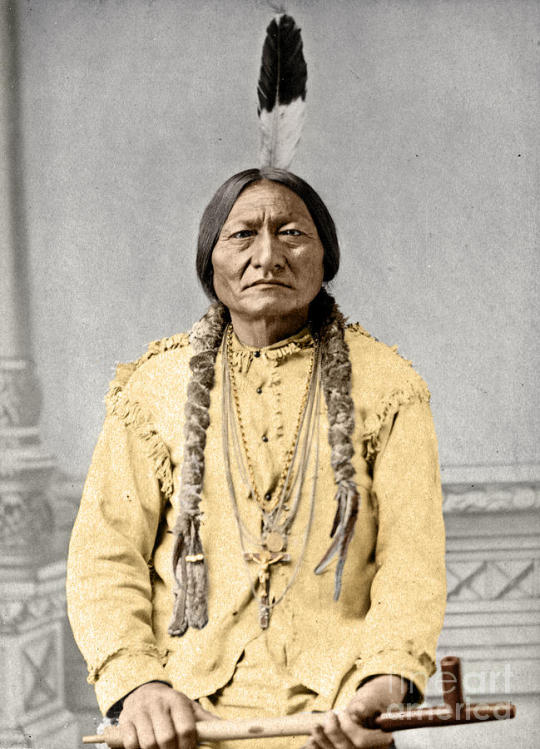
Sitting Bull, of the Hunkpapa Lakota, was a fierce political leader & holy man known to be a great father, husband, & friend to all. Under him, all the Lakota bands united for survival in the Northern Plains, as he spearheaded their resistance against European invasion. He was known for his legendary courage, unyielding defiance toward U.S. military power, & contemptuous of the many broken U.S. political promises.
Tatáŋka Íyotake was born to a prominent family of chiefs on the Grand River in present-day South Dakota at a place called, "Many Caches" - known for its abundant food storage pits. He was given his name, which described a buffalo bull sitting intractably on his haunches. This, he would grow live up to.
As a young man, Tatáŋka Íyotake joined two prominent groups within his community. He became a distinguished member of the Silent Eaters (a group concerned with tribal welfare) & leader of the Strong Heart Warrior Society. At 14, he joined his father & uncles on a raid against the Crow. Here, he first encountered White soldiers as the U.S. Army had mounted a broad campaign in retaliation for the Santee Rebellion in Minnesota, enchanting the Lakota had no affiliation with. That following year, in 1816, Tatáŋka Íyotake fought U.S. troops again at the Battle of Killdeer Mountain. Later, in 1865, he led a siege against the newly established Fort Rice in North Dakota. Widely respected for his bravery & insight, in 1868, Tatáŋka Íyotake became Head Chief of Lakota Nation.
By 1874, the stage for war between Sitting Bull & the US Army was set once an expedition led by General George Armstrong Custer confirmed gold had been discovered in the Dakota Territory’s the Black Hills, an area sacred to the Lakota bands. This land was decreed off-limits to white settlement by the Fort Laramie Treaty of 1868. Despite this ban, prospectors began a rush to the Black Hills. Once U.S. government efforts to purchase the Black Hills failed, the Fort Laramie Treaty was dismissed. The commissioner of Indian Affairs decreed that all Lakota not settled on reservations by January 31, 1876, would be considered hostile.
Rightfully so, Sitting Bull and his people held their ground. In March, 3 lines of federal troops invaded the area. Sitting Bull summoned the Lakota and their allies, the Cheyenne, & Arapaho to his camp on Rosebud Creek in Montana Territory. There, he led them in the sundance ritual, offering prayers to Wakáŋ Táŋka (Great Spirit). Sitting Bull slashed his arms 100 times in sacrifice for his people. During this ceremony, he shared that he'd had a vision. He saw soldiers falling into the Lakota camp like grasshoppers falling from the sky.
Inspired by this vision, the Oglala Lakota leader, War Chief Crazy Horse, set out for battle with a band of 500 warriors at the Battle of the Rosebud. To celebrate this victory, the Lakota moved their camp to the valley of the Little Bighorn River. They were joined by 3,000 more Native warriors who had abandoned the reservations to follow Sitting Bull.
On June 25th, the U.S. 7th Cavalry launched their attack under George Armstrong Custer. They rushed the Indian encampment as if in fulfillment of Sitting Bull’s vision. Yet they were severely outnumbered & thus defeated.
White outrage at this military catastrophe spurred thousands more cavalrymen to the area. Over the next year, they relentlessly pursued the Lakota bands.
Though many were forced into surrender, Sitting Bull remained defiant. In May 1877, he led his band to Canada, beyond the reach of the U.S. Army. When a U.S. General traveled north to audaciously offer him a pardon in exchange for settling on a reservation, Sitting Bull angrily dismissed him.
Four years later, in the wake of European invaders driving the Buffalo to near instinction, Sitting Bull found it nearly impossible to feed his people. So, he moved south to face surrender. On July 19, 1881, Sitting Bull’s young son handed his father’s rifle to the U.S. commanding officer of Fort Buford in Montana. Through this action, Sitting Bull hoped to teach his son “that he had become a friend of the Americans.” He also said, “I wish it to be remembered that I was the last man of my tribe to surrender my rifle.” He asked for the right to cross back & forth into Canada whenever he wished & for a reservation of his own on the Little Missouri River near the Black Hills. Instead, he was sent to Standing Rock Reservation. His warm reception there raised Army fears about a fresh uprising. So, Sitting Bull and his people were taken further down the Missouri River to Fort Randall. They were held as prisoners of war for nearly 2 more years.
Finally, on May 10, 1883, Sitting Bull rejoined his tribe at Standing Rock. The Indian Agent in charge of the reservation was determined to deny him any special privileges. And so, Sitting Bull was forced to work in the plantation fields. Yet when a delegation of U.S. Senators came to discuss opening part of the reservation to Whitea, he spoke forcefully, though futilely, against it.
In 1885, Sitting Bull was allowed to leave the reservation to join Buffalo Bill’s Wild West Show. He earned $50 a week for riding once around the arena. Sitting Bull also named his price for his autograph & picture. Unable to tolerate White society any longer, he stayed with the show for 4 months.
Returning to Standing Rock, Sitting Bull lived in a cabin near his birthplace on the Grand River; still rejecting the seeds of the colonialism - Christianity & giving up the traditional ways of life - as the reservation’s rules required. He did, however, send his children to a Christian school because he believed the next generation of Lakota would need the education of their oppressors to survive in the new world.
Here, he had another vision. He saw a meadowlark on a hillock beside him say,“Your own people, Lakotas, will kill you.” Nearly 5 years later, this vision would come to fruition.
In the fall of 1890, a Minŋecoŋjou Lakota named Kicking Bear came to Sitting Bull with news of the Ghost Dance, a ceremony that promised to rid the land of colonizers & restore the Indian way of life. Lakota had already adopted the ceremony at the Pine Ridge & Rosebud Reservations, and Indian Agents there had already called for troops to bring the growing movement under control.
At Standing Rock, the authorities feared Sitting Bull, still revered as a powerful spiritual leader, would join the Ghost Dancers as well. They sent 43 Lakota police officers to seize him. Before dawn on December 15th1890, the officers burst into Sitting Bull’s cabin & dragged him outside, where his followers were gathering to protect him. In the gunfight that followed, one of the Lakota police officers shot Sitting Bull in the head.
Today, Sitting Bull rests close to his birthplace near Mobridge, South Dakota. A granite shaft marks his grave.
"They claim this mother of ours, the Earth, for their own use, and fence their neighbors away from her, and deface her with their buildings and their refuse." - Sitting Bull.
We pour libations & give him💐 today as we celebrate him for his inspirational leadership, fearless figuring spirit, power in prayer, & his deep faith in Great Spirit.
Offering suggestions: a smoking pipe with tobacco, Lakota music, bison meat served with wild potatoes & prairie turnips
‼️Note: offering suggestions are just that & strictly for veneration purposes only. Never attempt to conjure up any spirit or entity without proper divination/Mediumship counsel.‼️
#hoodoo#hoodoos#atr#the hoodoo calendar#ancestor veneration#elevated ancestors#Sitting bull#Lakota Nation#Plains Indians#First Nations#Hunkpapa Lakota
39 notes
·
View notes
Text

Flying Hawk
Flying Hawk, also known as Moses Flying Hawk; March 1854 – December 24, 1931) was an Oglala Lakota warrior, historian, educator and philosopher. Flying Hawk's life chronicles the history of the Oglala Lakota people through the 19th and early 20th centuries, as he fought to deflect the worst effects of white rule; educate his people and preserve sacred Oglala Lakota land and heritage.

Chief Flying Hawk was a combatant in Red Cloud's War and in nearly all of the fights with the U.S. Army during the Great Sioux War of 1876. He fought alongside his first cousin Crazy Horse and his brothers Kicking Bear and Black Fox II in the Battle of the Little Big Horn in 1876, and was present at the death of Crazy Horse in 1877 and the Wounded Knee Massacre of 1890.
Chief Flying Hawk was one of the five warrior cousins who sacrificed blood and flesh for Crazy Horse at the Last Sun Dance of 1877. Chief Flying Hawk was the author of his commentaries and accounts of the Battle of the Little Big Horn, Crazy Horse and the Wounded Knee Massacre, and of Native American warriors and statesmen from who fought to protect their families, defend the invasion of their lands and preserve their culture. Chief Flying Hawk was probably the longest standing Wild Wester, traveling for over 30 years throughout the United States and Europe from about 1898 to about 1930. Chief Flying Hawk was an educator and believed public education was essential to preserve Lakota culture. He frequently visited public schools for presentations. Chief Flying Hawk leaves a legacy of Native American philosophy and his winter count covers nearly 150 years of Lakota history.
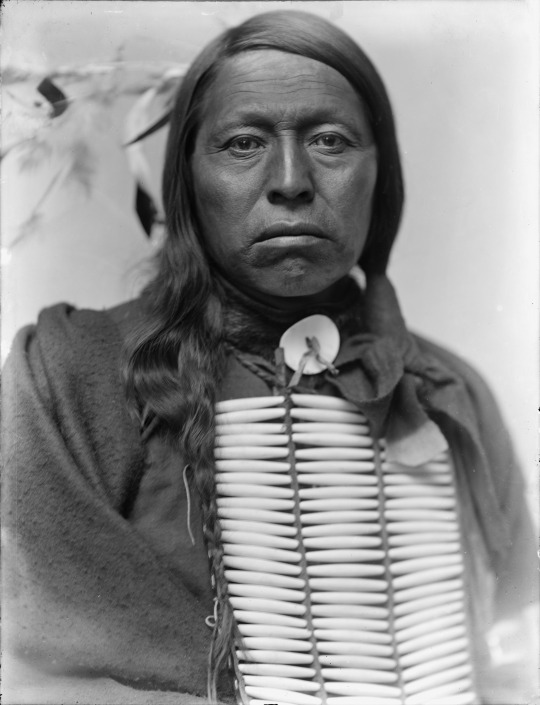
#historic photographs#chief flying hawk#lakota#sioux#little big horn#crazy horse#kicking bear#flying hawk#oglala lakota
170 notes
·
View notes
Text
Get to know the animals around you,
get to know the birds,
Get to know the land,
the water...
Because what you don’t know
you won’t understand,
And what you don't understand,
you will fear.
And what you fear, you will destroy.
– A poem by Kayah George's
great-grandfather, Chief Dan George
#team orca#indigenous#indigenous people#Salish#🖤❤️💛#crazy horse#sitting bull#chief joseph#tecumseh#Tupac Amaru#emiliano zapata#water is life
9 notes
·
View notes
Text

Little Hawk 1836–1900 was an Oglala Lakota war chief and a half-brother of Worm, father of Crazy Horse ...
67 notes
·
View notes
Photo

Sioux War Chief Gall (Eastman's Biography)
Gall (Phizi, l. c. 1840-1894) was a Hunkpapa Lakota Sioux war chief best known for his participation in the Battle of the Little Bighorn in June 1876. He was a close associate of Red Cloud (l. 1822-1909), Sitting Bull (l. c. 1837-1890), and Crazy Horse (l. c. 1840-1877) and was active in the resistance to Euro-American encroachment on Sioux lands.
He participated in raids on white settlers traveling the Bozeman Trail in the early 1860s but assumed a more prominent position beginning with Red Cloud's War (1866-1868) and continuing through the Great Sioux War of 1876-1877. Almost nothing is known of his youth except that he was an orphan, and his childhood name was Matohinsa (also given as Matohinshda, meaning "Bear-Shedding-His-Hair"). He was given his adult name (Phizi – "Man Who Goes in the Middle") in his teens after eating the gall bladder of an animal when he was hungry and later won a wrestling match against Roman Nose (Cheyenne warrior). Gall was adopted by Sitting Bull as a younger brother and trained by him as a warrior.
He was among the Sioux warriors (including Sitting Bull and Crazy Horse) who refused to sign the Fort Laramie Treaty of 1868 ending Red Cloud's War, continuing the resistance to US expansionist policies. At the Battle of the Little Bighorn, both of his wives and many of his children were murdered by the command under Major Marcus Reno, and he then countered Reno's charge, driving him toward the river and defeating him with the assistance of Cheyenne warriors.
When Sitting Bull retreated into the region of modern-day Canada in 1877, Gall followed, but broke with his mentor/adopted brother in 1881 and returned to the United States to surrender. He was arrested and regarded as a prisoner of war before being sent to the Standing Rock Agency reservation, where he remained the rest of his life as a farmer. He served as a judge and liaison between his people and the US government, converting to Christianity and advocating for peaceful relations with Euro-Americans, but as Eastman notes, his spirit seemed broken.
Text
One of the most important documents on Gall is the account given by Sioux author and physician Charles A. Eastman (also known as Ohiyesa, l. 1858-1939) in his Indian Heroes and Great Chieftains (1916), based on stories he had gathered on the war chief from those who had known him. Although not a first-person account, Eastman's work is regarded as more or less accurate and the closest to an authentic biography of Gall.
The following text is taken from the 1939 edition of Eastman's work, republished in 2016:
Chief Gall was one of the most aggressive leaders of the Sioux Nation in their last stand for freedom.
The westward pressure of civilization during the past three centuries has been tremendous. When our hemisphere was "discovered", it had been inhabited by the natives for untold ages, but it was held undiscovered because the original owners did not chart or advertise it. Yet some of them at least had developed ideals of life which included real liberty and equality to all men, and they did not recognize individual ownership in land or other property beyond actual necessity. It was a soul development leading to essential manhood. Under this system they brought forth some striking characters.
Gall was considered by both Indians and whites to be a most impressive type of physical manhood. From his picture you can judge of this for yourself.
Let us follow his trail. He was no tenderfoot. He never asked a soft place for himself. He always played the game according to the rules and to a finish. To be sure, like every other man, he made some mistakes, but he was an Indian and never acted the coward.
The earliest stories told of his life and doings indicate the spirit of the man in that of the boy.
When he was only about three years old, the Blackfoot band of Sioux were on their usual roving hunt, following the buffalo while living their natural happy life upon the wonderful wide prairies of the Dakotas.
It was the way of every Sioux mother to adjust her household effects on such dogs and pack ponies as she could muster from day to day, often lending one or two to accommodate some other woman whose horse or dog had died, or perhaps had been among those stampeded and carried away by a raiding band of Crow warriors. On this particular occasion, the mother of our young Sioux brave, Matohinshda, or Bear-Shedding-His-Hair (Gall's childhood name), entrusted her boy to an old Eskimo pack dog, experienced and reliable, except perhaps when unduly excited or very thirsty.
On the day of removing camp the caravan made its morning march up the Powder River. Upon the wide table-land the women were busily digging teepsinna (an edible sweetish root, much used by them) as the moving village slowly progressed. As usual at such times, the trail was wide. An old jack rabbit had waited too long in hiding. Now, finding himself almost surrounded by the mighty plains people, he sprang up suddenly, his feathery ears conspicuously erect, a dangerous challenge to the dogs and the people.
A whoop went up. Every dog accepted the challenge. Forgotten were the bundles, the kits, even the babies they were drawing or carrying. The chase was on, and the screams of the women reechoed from the opposite cliffs of the Powder, mingled with the yelps of dogs and the neighing of horses. The hand of every man was against the daring warrior, the lone Jack, and the confusion was great.
When the fleeing one cleared the mass of his enemies, he emerged with a swiftness that commanded respect and gave promise of a determined chase. Behind him, his pursuers stretched out in a thin line, first the speedy, unburdened dogs and then the travois dogs headed by the old Eskimo with his precious freight. The youthful Gall was in a travois, a basket mounted on trailing poles and harnessed to the sides of the animal.
"Hey! hey! they are gaining on him!" a warrior shouted. At this juncture two of the canines had almost nabbed their furry prey by the back. But he was too cunning for them. He dropped instantly and sent both dogs over his head, rolling and spinning, then made another flight at right angles to the first. This gave the Eskimo a chance to cut the triangle. He gained fifty yards, but being heavily handicapped, two unladen dogs passed him. The same trick was repeated by the Jack, and this time he saved himself from instant death by a double loop and was now running directly toward the crowd, followed by a dozen or more dogs. He was losing speed, but likewise his pursuers were dropping off steadily. Only the sturdy Eskimo dog held to his even gait, and behind him in the frail travois leaned forward the little Matohinshda, nude save a breech clout, his left hand holding fast the convenient tail of his dog, the right grasping firmly one of the poles of the travois. His black eyes were bulging almost out of their sockets; his long hair flowed out behind like a stream of dark water.
The Jack now ran directly toward the howling spectators, but his marvelous speed and alertness were on the wane; while on the other hand his foremost pursuer, who had taken part in hundreds of similar events, had every confidence in his own endurance. Each leap brought him nearer, fiercer and more determined. The last effort of the Jack was to lose himself in the crowd, like a fish in muddy water; but the big dog made the one needed leap with unerring aim and his teeth flashed as he caught the rabbit in viselike jaws and held him limp in air, a victor!
The people rushed up to him as he laid the victim down, and foremost among them was the frantic mother of Matohinshda, or Gall. "Michinkshe! michinkshe!" (My son! my son!) she screamed as she drew near. The boy seemed to be none the worse for his experience. "Mother!" he cried, "my dog is brave: he got the rabbit!" She snatched him off the travois, but he struggled out of her arms to look upon his dog lovingly and admiringly. Old men and boys crowded about the hero of the day, the dog, and the thoughtful grandmother of Matohinshda unharnessed him and poured some water from a parfleche water bag into a basin. "Here, my grandson, give your friend something to drink."
"How, hechetu," pronounced an old warrior no longer in active service. "This may be only an accident, an ordinary affair; but such things sometimes indicate a career. The boy has had a wonderful ride. I prophesy that he will one day hold the attention of all the people with his doings."
This is the first remembered story of the famous chief, but other boyish exploits foretold the man he was destined to be. He fought many sham battles, some successful and others not; but he was always a fierce fighter and a good loser.
Once he was engaged in a battle with snowballs. There were probably nearly a hundred boys on each side, and the rule was that every fair hit made the receiver officially dead. He must not participate further but must remain just where he was struck.
Gall's side was fast losing, and the battle was growing hotter every minute when the youthful warrior worked toward an old water hole and took up his position there. His side was soon annihilated and there were eleven men left to fight him. He was pressed close in the wash-out, and as he dodged under cover before a volley of snowballs, there suddenly emerged in his stead a huge gray wolf. His opponents fled in every direction in superstitious terror, for they thought he had been transformed into the animal. To their astonishment he came out on the farther side and ran to the line of safety, a winner!
It happened that the wolf's den had been partly covered with snow so that no one had noticed it until the yells of the boys aroused the inmate, and he beat a hasty retreat. The boys always looked upon this incident as an omen.
Gall had an amiable disposition but was quick to resent insult or injustice. This sometimes involved him in difficulties, but he seldom fought without good cause and was popular with his associates. One of his characteristics was his ability to organize, and this was a large factor in his leadership when he became a man. He was tried in many ways, and never was known to hesitate when it was a question of physical courage and endurance. He entered the public service early in life, but not until he had proved himself competent and passed all tests.
When a mere boy, he was once scouting for game in midwinter, far from camp, and was overtaken by a three days' blizzard. He was forced to abandon his horse and lie under the snow for that length of time. He afterward said he was not particularly hungry; it was thirst and stiffness from which he suffered most. One reason the Indian so loved his horse or dog was that at such times the animal would stay by him like a brother. On this occasion Gall's pony was not more than a stone's throw away when the storm subsided, and the sun shone. There was a herd of buffalo in plain sight, and the young hunter was not long in procuring a meal.
This chief's contemporaries still recall his wrestling match with the equally powerful Cheyenne boy, Roman Nose, who afterward became a chief well known to American history. It was a custom of the northwestern Indians, when two friendly tribes camped together, to establish the physical and athletic supremacy of the youth of the respective camps.
The "Che-hoo-hoo" is a wrestling game in which there may be any number on a side, but the numbers are equal. All the boys of each camp are called together by a leader chosen for the purpose and draw themselves up in line of battle; then each at a given signal attacks his opponent.
In this memorable contest, Matohinshda, or Gall, was placed opposite Roman Nose. The whole people turned out as spectators of the struggle, and the battlefield was a plateau between the two camps, in the midst of picturesque Bad Lands. There were many athletic youths present, but these two were really the Apollos of the two tribes.
In this kind of sport, it is not allowed to strike with the hand, nor catch around the neck, nor kick, nor pull by the hair. One may break away and run a few yards to get a fresh start, or clinch, or catch as catch can. When a boy is thrown and held to the ground, he is counted out. If a boy has met his superior, he may drop to the ground to escape rough handling, but it is very seldom one gives up without a full trial of strength.
It seemed almost like a real battle, so great was the enthusiasm, as the shouts of sympathizers on both sides went up in a mighty chorus. At last, all were either conquerors or subdued except Gall and Roman Nose. The pair seemed equally matched. Both were stripped to the breech clout, now tugging like two young buffalo or elk in mating time, again writhing, and twisting like serpents. At times they fought like two wild stallions, straining every muscle of arms, legs, and back in the struggle. Every now and then one was lifted off his feet for a moment, but came down planted like a tree, and after swaying to and fro soon became rigid again.
All eyes were upon the champions. Finally, either by trick or main force, Gall laid the other sprawling upon the ground and held him fast for a minute, then released him and stood erect, panting, a master youth. Shout after shout went up on the Sioux side of the camp. The mother of Roman Nose came forward and threw a superbly worked buffalo robe over Gall, whose mother returned the compliment by covering the young Cheyenne with a handsome blanket.
Undoubtedly these early contests had their influence upon our hero's career. It was his habit to appear most opportunely in a crisis, and in a striking and dramatic manner to take command of the situation. The best-known example of this is his entrance on the scene of confusion when Reno surprised the Sioux on the Little Big Horn. Many of the excitable youths, almost unarmed, rushed madly and blindly to meet the intruder, and the scene might have unnerved even an experienced warrior. It was Gall, with not a garment upon his superb body, who on his black charger dashed ahead of the boys and faced them. He stopped them on the dry creek, while the bullets of Reno's men whistled about their ears.
"Hold hard, men! Steady, we are not ready yet! Wait for more guns, more horses, and the day is yours!"
They obeyed, and in a few minutes the signal to charge was given, and Reno retreated pell mell before the onset of the Sioux.
Sitting Bull had confidence in his men so long as Gall planned and directed the attack, whether against United States soldiers or the warriors of another tribe. He was a strategist, and able in a twinkling to note and seize upon an advantage. He was really the mainstay of Sitting Bull's effective last stand. He consistently upheld his people's right to their buffalo plains and believed that they should hold the government strictly to its agreements with them. When the treaty of 1868 was disregarded, he agreed with Sitting Bull in defending the last of their once vast domain, and after the Custer battle entered Canada with his chief. They hoped to bring their lost cause before the English government and were much disappointed when they were asked to return to the United States.
Gall finally reported at Fort Peck, Montana, in 1881, and brought half of the Hunkpapa band with him, whereupon he was soon followed by Sitting Bull himself. Although they had been promised by the United States commission who went to Canada to treat with them that they would not be punished if they returned, no sooner had Gall come down than a part of his people were attacked, and in the spring they were all brought to Fort Randall and held as military prisoners. From this point they were returned to Standing Rock agency.
When "Buffalo Bill" successfully launched his first show, he made every effort to secure both Sitting Bull and Gall for his leading attractions. The military was in complete accord with him in this, for they still had grave suspicions of these two leaders. While Sitting Bull reluctantly agreed, Gall haughtily said: "I am not an animal to be exhibited before the crowd," and retired to his teepee. His spirit was much worn, and he lost strength from that time on. That superb manhood dwindled, and in a few years he died. He was a real hero of a free and natural people, a type that is never to be seen again.
Continue reading...
27 notes
·
View notes
Text
Reactions to Trash Boss's Chapter 129
New title - 19. Something's Different Here
TLDR; Background info of Demon Cult and Heavenly Demon. Heavenly Demon reached the Profound Realm and realized that he himself was a Living Jiangshi.
Soos?
LSH = ❌
CJS = ❌
Today's chapter was intense. That big reveal in the end was such a plot twist. As you all know, Living Jiangshi were described in the early chapters as Jiangshi who look "alive" or "living" and were unaware that they were even a Jiangshi. And now, we have a Living Jiangshi who realized that he was a Jiangshi... Woah 😮
I would like to correct myself. With how much 'Angry' Demon has been showing off his intelligence, I believe that 'Brain' is actually the correct translation rather than 'Angry'... So I will be calling him Brain Demon from now on.
Moving on, most of this chapter was just background information about Heavenly Demon, the Demon Cult, and their relationship to the Central Plains.
Google Translate was such a pain and a clown in this chapter. 😂 You see, the Korean word for "demon" was also the same word for "horse." Thus, except for "Demon Cult" and "Heavenly Demon" that MTL got correctly, every instance of "demon" got translated as "horse"... 🤣🤣🤣 MTL, stop horsing around... 🐎
Some more MTL wrong translations:
Government => Coffin
Great War of the Evil Faction and the Demon Cult => Great War of the Four Horses
Chief Eunuch Wi => Merchant Line, Merchant Ship, Upper Brow
Blood Cult => Blood Bridge, Blood Ties
Young Master Kim => Princess Kim, Confucius Kim, Gongja Kim
Living Jiangshi => Ginger Poet
Some stuff about Heavenly Demon. He's in his late thirties. And he experienced that cliche of being one of the many children of a man with multiple wives and concubines, so he had a miserable childhood. Fights between the wives and concubines were common, and he lost his mother when he was a kid. 😢
Brain Demon at that time was just a mid-level staff officer back then. Or more like, he was stuck in that position because he was an illegitimate child of a famous family in the Demon Cult. However, after he became Heavenly Demon's mentor and right-hand man, his position and influence rose.
During Brain Demon's conversation with Jegal Mi Ryeo, he realized that the negotiation was just a cover and something else was up. So he requested a meeting with Young Master Kim whom he thought as the mastermind behind this. See... he really is the "Brain" Demon.
After this was the slow reveal about Heavenly Demon. Brain Demon revealed to Cale that Heavenly Demon reached the Profound Realm, the highest martial arts rank, last month and came to a realization.
Heavenly Demon realized that he had things he both wanted and not wanted to do. That he was now fighting against himself. That he had been brainwashed. That the Blood Cult was behind all these... That he was a Living Jiangshi himself.
Dang, reading that part was so shocking and sad. He did his best to overcome all the hardships in his past, and risked his life in training to become stronger. And what did he get in the end? The realization that it might be all for naught. And when Cale purifies him, he'll never be able to use martial arts again.... So sad 😭
Now, how much blood will Cale spill when he purifies someone with the highest martial arts rank? Will the two elixirs he consumed a while ago help lessen the backlash he'd suffer from the purification process?
To end, I'm excited for the next chapters and Cale's visit to the Demon Cult. The buildup for this murim arc is crazy, and I hope that the author will not disappoint us in Cale crushing those Blue Blood hunters.
102 notes
·
View notes